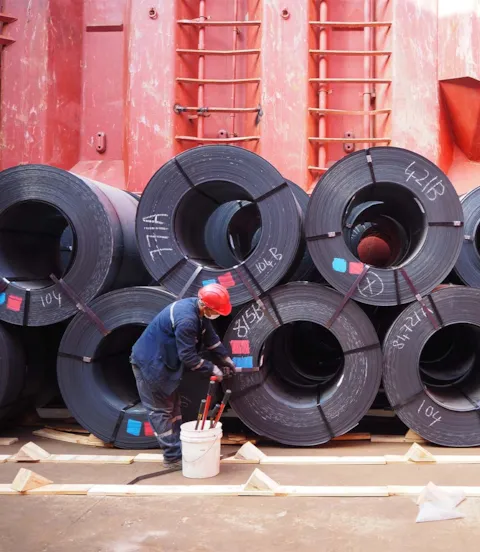Using smart digital solutions to support steel coil loading
Steel coils come in various sizes and weights, making it challenging for ship managers and operators to assess whether their vessels are suitable for a proposed shipment. DNV’s new Steel Load Planner app helps ship operators to overcome this challenge, while providing a range of other benefits.
The launch of DNV’s Steel Load Planner earlier this year marks a major breakthrough by significantly simplifying and optimizing the complex process of steel coil loading. The innovative app – which won the IT Solutions Award at the International Bulk Awards in London in November 2023 – revolutionizes the process for customizing vessel loading plans to accommodate diverse steel coil dimensions. By enabling swift calculations for optimized cargo intake, ensuring regulatory compliance, and mitigating the risk of maritime accidents, the Steel Load Planner heralds a new era in safe and efficient sea freight operations.

Complexity of coil load distribution
Steel coils of various weights and sizes are typically loaded on wooden dunnage, with their axis oriented in the ship’s longitudinal direction. The weight of the steel coils is transferred by the dunnage onto the bottom structure of the vessel.
The force of this weight is not distributed uniformly across the tank top but is transferred as concentrated loads through the dunnage. This means that the permissible uniform distributed load information in tons per square metre (t/m²) – as provided in a ship’s loading manual – cannot be used as a basis for determining the maximum load when carrying steel coils, making basic steel-loading methods problematic.

Customer collaboration drives development of Steel Load Planner app
With cargo planners needing reliable information to determine quickly whether a given type of steel coil could be transported by their vessel, many fleet managers have approached DNV for a better solution.
“We have been receiving a lot of requests from different customers to evaluate their loading plans,” explains Tatiana Tzeferakou, Head of Section, ERS Hull and Materials at DNV. “It would normally take about three weeks to confirm because we would need to model each cargo hold of every vessel.”

Previous solution lacks flexibility
Prior to 2023, common industry practice has been for customers to evaluate pre-defined coil arrangements on steel coil loading tables, usually based on spreadsheets. However, this is still relatively time consuming and lacks the flexibility of calculating loading arrangements for diverse steel coils.
“Our customers – mainly operating geared bulk carriers and general cargo ships that can carry steel coils – needed more flexibility as these coils come in different weights and sizes,” explains Tzeferakou. “They were looking for a solution that provides guidance on optimal vessel-loading techniques and cargo hold optimization, for diverse steel coil loads.”

Complexity of steel loading leads to development of the Steel Load Planner app
The increasing complexity of these requirements drove the development of DNV’s Steel Load Planner – a user-friendly app that can be used to customize a vessel’s loading plan for steel coils of any size. Key to the functionality of the app is the ability to test, update and confirm tailor-made loading plans for diverse steel coil loads instantly.
“The Steel Load Planner app can be used for all kinds of steel coil types. There’s no limit to the variety of steel coils you can incorporate and you can mix and match various lengths, diameters and weights as needed. Now it is also possible to have full, half or quarter tiers and even reduce the load on weaker structural members, such as the duct keel, if needed,” continues Tzeferakou. “This enables cargo planners to create custom loading plans with a high degree of flexibility.”

App can be used with a few simple steps
Before using the Steel Load Planner app for the first time, customers need to send DNV key information about the relevant dimensions and characteristics of their vessels. This is then pre-programmed into the app, saving time and effort at a later stage. With the app already familiar with a vessel’s structure, customers will then manually input the specific steel coil data for their next shipment.
“It’s a few simple steps,” says Tzeferakou. “They create the shipment in the application and describe the different coils by length, diameter and weight, noting how many of them they have. Then they enter the cargo hold and utilize the ‘tier arrangement’ function to arrange the steel coils based on their preferences. This can be done manually or by using predefined arrangement plans in the application.”

Advantages of the SLP app
Using the Steel Load Planner app provides customers with instant results, saving valuable time. However, the benefits go far beyond this, mainly due to the load optimization which is facilitated by the app.
“After entering their inputs, the app generates a report confirming rule compliance, ensuring sufficient capacity of the plate and stiffener,” explains Tzeferakou. “Additionally, the report indicates the percentage of optimization achieved. A 100% optimization signifies the best possible loading. Anything below 100% indicates reserve capacity, allowing for the addition of more coils, or a reduction in the amount of dunnage used."

Increased cargo loads provides multiple benefits
Early data shows that this optimization benefit is enabling vessels to increase cargo loads by up to 10%.
“This benefits all parties,” says Tzeferakou. “For the customers, increased cargo loads means more revenue. For the environment, this means less fuel consumption and fewer emissions per ton. So it’s both environmentally friendly and highly cost-effective, especially with the EU carbon pricing scheme just around the corner.”

Steel Load Planner app expected to become industry norm
Safety benefits are also attractive to customers. By optimizing loads according to regulations and broader safety standards, this service offers users the assurance that their vessel isn’t overloaded, reducing the risk of accidents and incidents.
“With a wide range of benefits, such as instant verification, load flexibility, increased cargo load, reduced emissions and increased safety, the Steel Load Planner is going to be a real game changer for our customers,” concludes Tzeferakou. “We expect this to become the norm in the industry very soon.”
- Shutterstock
- Amarinj - stock.adobe.com
- Shutterstock / Wathit Kettap
- DNV
- Shutterstock / Paullawat